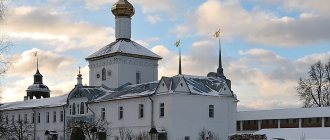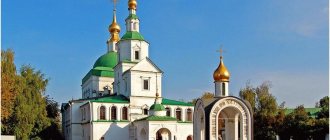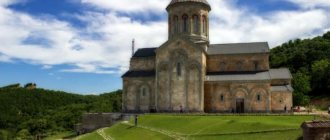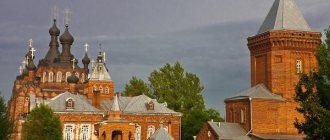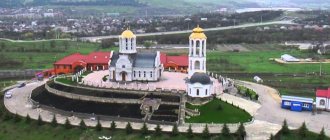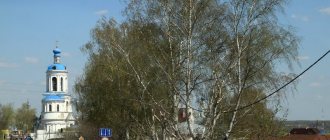The Holy Vvedensky Convent is one of the Orthodox pearls of Ivanovo; it is located in the very heart of the city.
The monastery was founded in 1991.
The site where the Orthodox women's monastery was built is unique in itself. Near it, another shrine was erected - the Church of the Entry of the Blessed Virgin Mary, which, according to the time of its construction, dates back to the beginning of the 20th century, and at the moment is an integral part of the monastery.
© Kin kuma
The monastery contains particles of the relics of 168 Orthodox martyrs; one of the most revered shrines is the cassock of John of Kronstadt.
Today, more than 150 nuns permanently reside in the Holy Vvedensky Monastery. And each of them is busy not only with prayers. The novices of this monastery devote a lot of time to charity.
In addition, the monastery is actively involved in social projects, as well as educational functions: they work at the Orthodox radio station "Radonezh", visit women's colonies, where they conduct services for believers, and work on a special commission for the canonization of saints. The nuns of the Holy Vvedensky Convent also support the poor by holding charity dinners, and there is a helpline.
The monastery has its own publishing department, with the help of which books, booklets on Orthodox topics and the monastery newspaper “Word of Consolation” are published. A sister choir has been organized in the monastery. You can listen to recordings of the choir on the official website of the Vvedensky Monastery.
© Vvedensky Convent
History of the Presentation Church
In 1900, a gathering of peasants from Ushakovo and Yama took place, and they decided to build a new temple in the township part of the city. The site for the church was allocated by order of Count Sergei Dmitrievich Sheremetyev, and it was decided to raise funds for it through private donations. The construction commission of peasants and the manager of the patrimonial office of the Sheremetyevs K.F. took on the task of collecting money. Knorre, as well as Pavel Nikanorovich Derbenev, the mayor of the then Ivanovo-Voznesensk.
St. Vedensky Monastery in urban areas
Derbenev belonged to a wealthy family of textile industry owners, and his grandfather, Timofey Vasilyevich, organized the first weaving workshop back in the 30s of the 19th century. Through the efforts of the Derbenev family, by the beginning of the 20th century, their manufacturing production in Ivanovo-Voznesensk had grown greatly, and almost 6.5 thousand people worked in textile factories. In addition to the mayor, the honor of sponsoring the construction belongs to local manufacturers I.K. Marakushev, N.G. and N.H. Burylin, I.A. Sokolov, M.N. Garelin and P.I. Vitova. Money for the temple was also given by city employees, factory workers and anonymous donors.
General view of the Holy Vedensky Monastery
The design of the new church was carried out by Pyotr Gustavovich Begen, a provincial architect who built many buildings in the Vladimir province and in Ivanovo-Voznesensk itself.
Finally, in 1901, the ceremonial laying of the temple took place, and construction work began, the direct supervision of which was entrusted to the architect Alexei Fedorovich Snurilov.
Six years later, the temple was consecrated. With money donated by industrialists Burylin, in the art workshop of A.I. Shorokhov, a beautiful three-tiered iconostasis was cut out for the new church. And a wooden bell tower was erected in the south-west of the main building.
View of the Holy Vedensky Monastery from Sheremetevsky Prospekt
Three chapels were installed in the church. The central one was dedicated to the Entry of the Mother of God into the Temple, and the side ones to St. Nicholas and the Great Martyr Theodore Tiron. The new temple turned out to be very beautiful, and its floor, which was covered with multi-colored Metlakh tiles, was especially impressive. From the church chronicle it is known that the first priest of the temple was Mikhail Stepanovich Kokhomsky.
The Vvedenskaya Church stood on the poor, working-class outskirts of the city, and its parish community constantly had problems with funds. Due to lack of finances, the church was not painted, and parishioners purchased liturgical utensils and necessary building materials on credit.
View of the Holy Vedensky Monastery from Spartak Street
In 1914, the community received permission from church authorities and began to seek funds to build a stone bell tower. Two years later, the full-time architect of the diocese L.M. Scherer created her project. However, the authorities considered that the place was chosen poorly, and the bell tower was never built.
In 1918, Patriarch Tikhon (Bellavin) visited the Church of the Presentation and held a service here. By the mid-30s of the last century, the authorities transferred first one of the premises to the branches of the Renovationist Church, and then the entire temple. But in 1938 the church was closed, and its interior decoration and icons were looted.
View of the monastery bell tower against the background of the Church of the Entry into the Temple of the Blessed Virgin Mary
In the middle of the Great Patriotic War, on the initiative of the townspeople, attempts were made to resume religious services, but this was never done. For more than 50 years, the temple, as a religious building, was inactive and was used for the regional state archive. Church services have been held here only since 1990.
The first service in a dilapidated temple
Father Ambrose conducted this service on Easter night. The service took place in the quiet glow of the stars under the open sky. The condition of the temple was deplorable: dilapidated walls studded with logs, broken windows, leaking roof. However, the main thing was accomplished - service to the Lord began. A long journey of seventy years has been overcome, and the struggle is finally over.
Day by day the church was gradually restored. Today you can see with your own eyes how the Holy Vvedensky Convent (Ivanovo) has been transformed. The photos show an amazingly beautiful temple, which is undoubtedly a decoration of the city. Construction and finishing work on the territory of the monastery continues to this day. New buildings of the monastery are growing, the walls of the temple itself are being transformed and renewed.
History of the monastery
The founder and spiritual leader of the monastery was Archimandrite Ambrose (Yurasov). In 1990, he was appointed rector of the Vvedensky Church, which was returned to believers. And a year later, the parish of this church, by decree of the patriarch, was turned into a nunnery.
View of the Staircase Tower and Cell Building
For several years, members of the parish community and volunteer helpers had to restore the Vvedensky Church, erect new cells and equip the monastery territory. They dismantled the ceilings made in the church during the years of the archive's existence, removed old shelving and garbage from the buildings, and installed crosses on the domes. It took a lot of time to create two new carved iconostases and paint icons for them.
Today the Vvedenskaya monastery is distinguished by active missionary activity. The monastery organizes charity dinners for low-income citizens. The monastery is actively involved in publishing activities - the newspaper “Word of Consolation” is published here, Orthodox books and booklets are published. In addition, everyone can get the necessary advice by calling the helpline created in the monastery.
View of the domes of the Vvedenskaya Church
Irreconcilable struggle for the temple
In 1988, attempts to return the temple were resumed. With the blessing of Father Ambrose, twenty believers were gathered - this was precisely the condition set by the Soviets for opening the church. In the fall of the same year, the Council for Religious Affairs finally gave its positive answer in the form of a document allowing the community to register.
However, victory was achieved only on paper. For the next two years, the church community, with the blessing of Bishop Ambrose, persistently fought for the Red Church. Believers wrote to various authorities, the Bishop himself appealed to government officials, but there was no response.
The culmination of these events was the spring of 1989. On March 17, it was planned to hold a rally for the Red Church. The authorities refused, and on the 21st, not far from her, near the Sovremennik cinema, four representatives of the church community settled down and went on a hunger strike in favor of opening the temple. A day later they were forcibly transported to the territory of the Red Church. The hunger strike lasted ten days. All this time, women were threatened with death, there were people who spat at them, the authorities threatened Father Ambrose and his followers through newspapers, protests were organized against the demands of believers with slogans calling for an end to the hunger strike.
Architectural monuments on the territory of the monastery
The modern monastery ensemble is distinguished by the integrity of its architectural design. It was built in the Russian style, but has individual eclectic elements. The front masonry of all its buildings is made of red brick, which determined the unofficial name of the monastery - the Red Church.
The architectural dominant of the entire complex is the pillarless, five-domed Vvedensky Church, which stands right in the center of the fenced monastic territory. It is an architectural monument of the early 20th century. The main volume of this church is a two-height cube with semicircular altar apses. The interior of the temple is a beautifully lit spacious hall.
Entrance to the Vvedensky Temple
The church roof is crowned with five massive, slightly flattened onion-shaped domes. Its entrances are decorated with arched openings. The windows on the facades are also decorated with arches. In addition, the temple is richly decorated with columns of various sizes and shapes, flies, kokoshniks, decorative jagged belts and multi-stage cornices, which use motifs of Byzantine architecture.
In addition to the temple, the monastery has a parable house, which was built in the eastern part of the site in 1909. This house looks very original. It is a building of two floors, placed at an angle, and vaguely resembles the boyar chambers of the 17th century. Attached to the rounded corner projection is a round tower, with a picturesque top in the form of a tent, and inside it there is a staircase. The rectangular windows of the parable house are decorated with platbands and other elements that replicate the decor of the Vvedensky Church.
Wall painting in the Vvedensky Church
The monastery fence was built in 1912. It consisted of brick pillars and forged metal gratings between them. It is interesting that the gratings in different parts of the fence had different patterns. Richly decorated gates were installed on three sides of the fence, and on two corners there were turrets, which in decoration were in harmony with the tower of the parable building.
When they began to create a new monastery in the 1990s, the supporting fence posts were built into the walls of the new monastic buildings, and the bars were removed. At the same time, a low bell tower with a belfry appeared above the western gate, which was built according to the design of the architect I.K. Rusakomsky.
Chapel of Ambrose of Milan
Modernity
The Holy Vvedensky Monastery is an architectural monument and a center of spiritual life in Ivanovo, where not only spiritual and educational work is carried out, but also active social work.
Architecture and interior
Over the years of the monastery's existence, the territory on which it is located has changed significantly. Thanks to the actions of nuns, parishioners and patrons of the arts, the Vvedensky Cathedral was completely restored. The pillarless five-domed cathedral, built of red brick, is the architectural dominant not only of the monastery territory, but also of the entire surrounding area. The powerful central apse and volumetric projections of the western, northern and southern facades give the church a cruciform shape.
Current status and visiting hours
The Vvedenskaya monastery is a functioning convent, which anyone can enter. A pilgrimage service has been created there and a museum of the Ivanovo New Martyrs has been opened.
170 nuns permanently live on the main territory and in the farmsteads (in the Preobrazhensky and Pokrovsky monasteries, as well as in the Sergius Hermitage). The monastery church houses the miraculous icon of the Mother of God “Quick to Hear,” reliquaries with particles of the relics of Christian saints, as well as a cassock that belonged to John of Kronstadt.
Prediction of Saint Leontius
All these events attracted the attention of not only Ivanovo residents, but also residents of other cities both in the USSR and around the world. This was mentioned in the news. Christian communities in different countries began to collect signatures in defense of believers.
What was said by Archimandrite Leonty Mikhailovsky came true, who, foreseeing a long struggle for the temple, said that it would be given away, but the whole world would need to shout about it.
The women who went on hunger strike were forcibly sent to the hospital, where the secretary of the regional executive committee talked with them for a long time. The official urged them to stop the protest. The women agreed only after promising that this issue would be resolved as soon as possible.
Resonance did not ensure a quick victory, but it made it possible to find many like-minded people who contributed to the opening of the Holy Vvedensky Convent (Ivanovo). And with common efforts, on Holy Week 1990, the keys to the church were finally given to the church community.
How to get there
View of the Priestly Corps and the southwestern tower from the monastery grounds
The monastery is located in the center of Ivanovo, on the street. Basic, 23.
Its territory is located 1 km from the railway station - one public transport stop.
By car. You can get from the capital to Ivanovo along the M7 highway in 4.5-5 hours (290 km). From the southern outskirts of the city to the monastery, the journey takes about 15 minutes and runs along Lezhnevskaya, Bubnova, Sadovaya streets and Sheremetyevsky Prospekt.
Church of the Presentation of the Blessed Virgin Mary into the Temple
By train or bus. From Yaroslavsky Station in Moscow to Ivanovo the train takes 7 hours. The railway station is located in the central part of Ivanovo. In addition, from the Moscow Central Bus Station at the Shchelkovskaya metro station you can get to Ivanovo in 6 hours by direct or transit buses. The bus station in Ivanovo is located in the southern part of the city and is 6.5 km away from the railway station. Around the city there are buses No. 12, 14, 15/4, 20, 32, 120, 129, trolleybuses No. 2, 6, 9, 11 and shuttle buses No. 18, 129, 135, 144 (stop “St. Vvedensky Monastery” "). From the train station to the monastery you can walk or take a taxi in 15 minutes.
Attraction rating:
Rating 5.00 [2 vote(s)]
| ← IVANOVO | IVANOVO REGION | RUSSIA → |
Schedule of services
Divine services in the Vedeno Church are held every day. The schedule depends on the day of the week.
During weekdays:
- 6.30 - morning prayers
- 8.00 - Divine Liturgy
- 17.00 - evening service
On weekends:
- 7.40 — liturgy
- 17.00 — All-night vigil.
The schedule of services may change on holidays.
Schedule of services on the official website of the Vvedensky Monastery in Ivanovo
Assumption Monastery[edit]
In the southeast of modern Ivanovo, from the beginning of the 18th century, there was the Assumption Pogost. In 1815, monks from the Intercession Monastery, with the permission of Archimandrite Xenophon, moved a wooden church to this old cemetery. And five years later, a bell tower was built at the old church, the design of which, made in the traditions of mature classicism, was prepared by the provincial architect Evgraf Yakovlevich Petrov.
However, time passed, and the wooden church grew old and collapsed. Therefore E.Ya. Petrov created a project for a new brick church. The expensive stone construction was sponsored by Ivanovo-Voznesensk industrialists - Nikolai Stepanovich Shodchin and Kosma Ivanovich Butrimov. Large-scale construction work lasted for 9 years. The building was completed with the money of Anton Nikolaevich Shodchin. The cemetery church was finally ready by the fall of 1843, and Archimandrite Polycarp consecrated it.
Telephone
: +7 (4932) 41-04-84
Website
: https://iv-eparhya.blogspot.ru/
Address
: 153000 Ivanovo, st. Smirnova, 76
Assumption Zolotnikovskaya men's hermitage[edit]
Address:
155035 Ivanovo region, Teykovsky district, village Zolotnikovskaya Pustyn, 38 V
Telephone:
+7 (910) 694-00-58
Email:
Directions:
From Suzdal or Ivanovo. It is located 150-200 m west of the modern Ivanovo-Suzdal-Vladimir highway.
The Zolotnikovskaya Assumption Hermitage was founded as a men's monastery in the first quarter of the 17th century by the monk Jonah Golovtsin. Currently it has the status of a metochion of the Nikolo-Shartomsky Monastery.
Nikolo-Shartomsky Monastery in Vvedenye[edit]
Architect
:
1817: Maricelli G. - construction on his own. project (fence)
Address
: Ivanovo region, Shuisky district, village. Introduction
The exact time of the founding of the monastery has not been established; there are several legends. According to one of them, the monastery received its name from the river, formerly called Shartoma (Shakhma), which flows into the Molokhta River not far from the monastery. At the confluence of this with the Teza River the monastery is located. According to another legend, in the second half of the 12th century, the fugitive slave of Prince Yuri Dolgoruky Nikola Shart with his comrades Fedos, Sidor and others settled on the banks of an unnamed river, which they called Shartoma, soon built a monastery, and the founder became the first abbot. In the spiritual letter of the Nizhny Novgorod appanage princess Maria, there is a legend that the monastery was built in honor of the icon of St. Nicholas the Wonderworker found on the banks of the Shartoma even before the reign of the Grand Duke of Moscow Vasily the Dark.
Monastery of the Life-Giving Cross (Pogost-Cross)[edit]
Address:
155060, Russia, Ivanovo region, Ilyinsky district, Pogost Krest village
Phones:
+7 (905) 106-98-60; +7 (960) 513-17-69
The Monastery of the Life-Giving Cross was founded in 1998 on the site of the appearance on May 29/June 11, 1423 to local shepherds of the Life-Giving Cross of the Lord with St. Nicholas the Wonderworker standing before him. On the site of the Nikolsky churchyard before the appearance of the Cross of the Lord there was a large swamp called Sakhotsky, which after the appearance of the Cross miraculously dried up overnight, forming a place for the construction of a church. In memory of the miraculous phenomenon, the built church was consecrated in honor of St. Nicholas the Wonderworker with a chapel in honor of the origin of the venerable tree of the Life-giving Cross of the Lord.
Makariev-Reshemsky Convent[edit]
Address
: Ivanovo region, Kineshma district, village. Reshma, st. Volzhskaya, 10
Makariev-Reshemsky Monastery is an Orthodox convent in the Ivanovo region. Founded at the end of the 14th century by the Monk Macarius of Zheltovodsk and Unzhensky himself. It was finally closed in 1927 and returned to the Church in 1994.
Currently, six nuns, two nuns and three nuns work in the monastery.
The confessor of the monastery is Priest Vladimir Smirnov. The monastery is in dire need of help and support, as it has no reliable means of subsistence. The area is surrounded by a temporary fence; the houses serving as housing for the sisters are located outside the monastery territory, in different places in the village, and are insufficient to accommodate newly arriving nuns.
Kazan Monastery (Kuznetsovo)[edit]
Address:
Russia, Ivanovo region, Shuisky district, village. Kuznetsovo, 22
Telephone:
(49351) 3-48-42
Email:
Directions:
Shuya bus number 7, stop with. Mikhalkovo, then walk 1 km to the village. Kuznetsov.
In April 1998, at the request of His Grace Archbishop Ambrose of Ivanovo and Kineshma to transform the monastic community into a monastery, at a meeting of the Holy Synod it was decided to bless the opening of the Dormition-Kazan Monastery.
Svyatoezerskaya Iverskaya women's hermitage[edit]
Address:
Ivanovo region, Yuzhsky district, Mugreevsky village, st. Embankment, 2
Telephone:
8-(493)-472-47-90, 8-980-682-09-18, 8-915-821-32-22
According to legend, the Svyatoezerskaya Hermitage monastery was founded at the turn of the 14th-15th centuries. Saints of Moscow Cyprian and Photius. In 1764, the sparsely populated monastery was abolished and turned into a parish.
In 1863, the monastery was reopened, but as a monastery.
After 1917, the monastery was destroyed and looted.
In 1923, the religious community of the monastery was restored; in 1928, the monastery was finally closed, the churches were turned into warehouses, and the cell buildings were inhabited by peat miners. In 1993, Archbishop Ambrose (Shchurov) blessed the opening of a parish in one of the churches of the former desert, and in 1998 he sent nun Georgia (Dirks) to the village of Mugreevsky to carry out work on the restoration of the monastery.
In 2001, the opening of the female monastery “Svyatoezerskaya Iverskaya Hermitage” by the Holy Synod took place. Until 2011, nun Georgia managed a monastery of up to 30 sisters. With the blessing of His Eminence the Most Reverend Bishop Joseph, nun Silouana (Volkova) is currently the acting abbess of the monastery.
Assumption Dunilovsky Convent[edit]
Date of foundation
: con. XVII century
Address
: Ivanovo region, Shuisky district, village. Dunilovo
Telephone
: (09351) 4-31-41
Initially, the hermitage was founded as a men's village by the boyar Lopukhin Fedor Abramovich. Abolished in 1764, all the wooden buildings of the monastery were burned. In the 19th century, two parish churches were built on the site of the abolished desert - Assumption and Pokrovsky. During Soviet times, the churches were closed and transferred to a psychoneurological boarding school, which took the place of the former monastery. In 1991, the Assumption Monastery for women was opened on the site of the former Vorovyevskaya Hermitage.
Notes
: The village of Dunilovo was presented to Lopukhin F.A. on the occasion of the marriage of his daughter Evdokia and Sovereign Peter Alekseevich.
Resurrection Feodorovsky Monastery[edit]
Date of foundation
: 1881
Address
: Ivanovo region, Shuisky district, village. Sergievo
Web
: https://fmonastyr.ru/
Founded in 1881 by the wealthy landowner A.N. Shubina on the site of the estate, which she bought from her uncle, the landowner N.M. Markov. A.N. Shubina had extensive connections in St. Petersburg with the royal court and the highest clergy. She received the blessing to open the monastery from the now famous Fr. John of Kronstadt.
Closed in 1929, the territory housed a colony for juvenile delinquents; in the 1950s it was transferred to the Shuya Agricultural College. In 1994 it was returned to the diocese, and in 1998 it was revived as a monastery.
